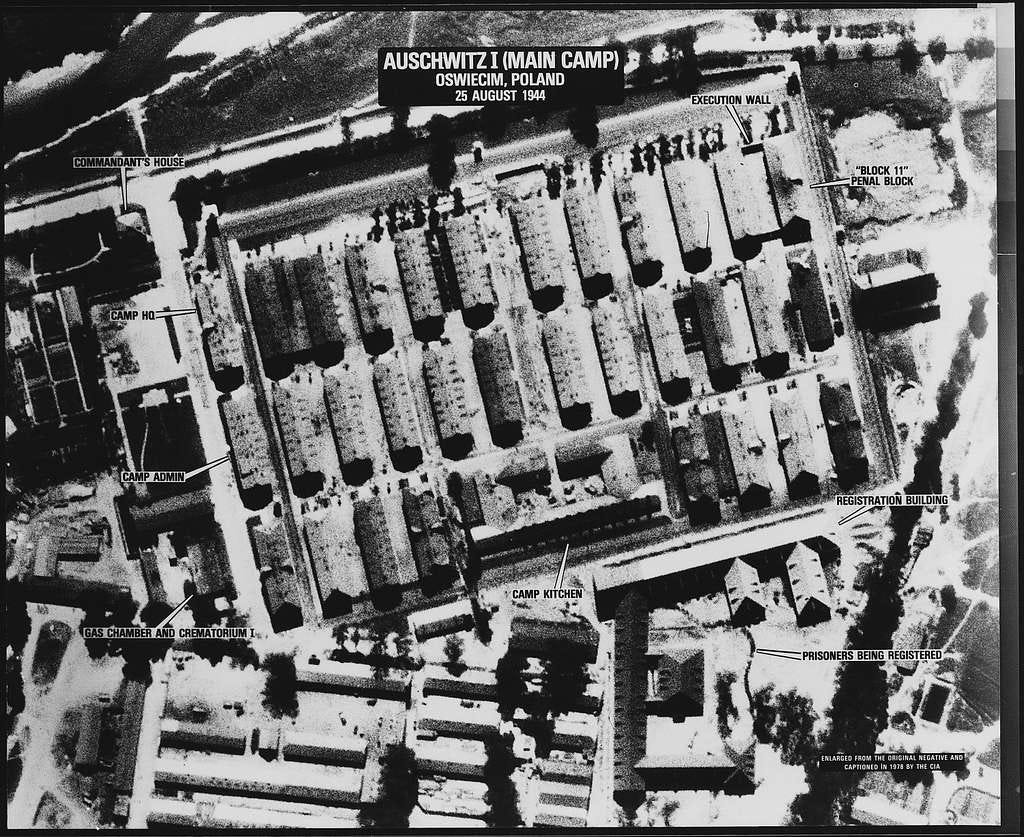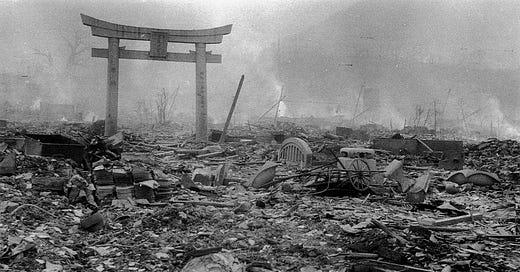The Horrific Shout of the Anthropocene
Ecocritical Reflections on WWII, the Holocaust, and Hiroshima & Nagasaki bombs
This article is dedicated to the Shoah Memorial Day, Jan 27th 2025, a time to remember and reflect on the profound human and ecological consequences of the Holocaust and the Second World War. As we honor the memory of those who perished, we also broaden our understanding of the larger-than-human tragedies of this era, inviting a deeper reckoning with the interconnectedness of life, memory, and the environment.
The Second World War was a cataclysm that reshaped the course of human history, the landscape of the Earth, and the ontology of life itself. Beyond its devastating toll on human life, the war marked a profound rupture in the relationship between humanity and the natural world. From the Holocaust to the annihilation of Hiroshima and Nagasaki, the events of this era signal not only a human tragedy but an environmental and existential crisis. We can broaden our understanding of these events through an ecocritical lens to examine their larger-than-human implications and how they continue to influence life on Earth.
As Primo Levi writes in If This Is a Man:
“…Consider if this is a man/who works in the mud/ who does not know peace/ who fights for a crust of bread/ who dies at a yes or a no. /Consider if this is a woman/without hair and without name/ with no more strength to remember/ her eyes empty and her womb cold/like a frog in winter.”
Levi’s words transcend individual suffering, evoking an existential void that affects all of life. Similarly, in the shadow of the atomic age, John Hersey’s Hiroshima captures the unfathomable scale of destruction, and its ironic and inexplicable paradoxical effects.
reporting Miss Sasaki’s memories:
Over everything—up through the wreckage of the city, in gutters, along the riverbanks, tangled among tiles and tin roofing, climbing on charred tree trunks—was a blanket of fresh, vivid, lush, optimistic green; the verdancy rose even from the foundations of ruined houses. Weeds already hid the ashes, and wild flowers were in bloom among the city’s bones. The bomb had not only left the underground organs of plants intact; it had stimulated them. Everywhere were bluets and Spanish bayonets, goosefoot, morning glories and day lilies, the hairy-fruited bean, purslane and clotbur and sesame and panic grass and feverfew. Especially in a circle at the center, sickle senna grew in extraordinary regeneration, not only standing among the charred remnants of the same plant but pushing up in new places, among bricks and through cracks in the asphalt. It actually seemed as if a load of sickle-senna seed had been dropped along with the bomb.
These literary reflections frame the Holocaust and nuclear devastation as events that extend beyond human suffering, implicating the life on Earth itself in their aftermath.
The Holocaust: Landscapes of Trauma and Ecological duplicty
The Holocaust is one of the most studied and remembered atrocities of the 20th century. Yet its environmental dimensions are less frequently examined. The Nazi regime's genocide unfolded within landscapes that were both shaped by and ‘complicit’ in the machinery of extermination. Forests, fields, rivers, and even the air became unwilling participants in the horrors of the Holocaust.
"Never shall I forget that smoke. Never shall I forget the small faces of the children whose bodies I saw transformed into smoke under a silent sky.” Elie Wiesel - Night
The physical locations of extermination camps such as Auschwitz-Birkenau, Treblinka, and Sobibor were deliberately chosen for their isolation and accessibility via railway networks. These landscapes were transformed into sites of industrialized death, where the natural world was forced to bear witness to atrocities. The ecological aftermath of these sites includes soil and water contamination from mass graves and the pervasive imprint of trauma on the land. Today, these sites are both memorials and living ecosystems, where nature continues to grow over the scars of history. This dual role of nature—as a silent witness and as a force of regeneration—challenges us to consider how landscapes embody memory and forgetting.

The Atomic Singularity: Hiroshima, Nagasaki, and the Ontology of Life
The detonation of atomic bombs over Hiroshima and Nagasaki in August 1945 introduced an unprecedented kind of devastation. In an instant, entire cities were obliterated, and the fabric of life was irrevocably altered. The mushroom cloud that rose over these cities became an icon of a new era, one in which humanity gained the power to annihilate not only itself but also the biosphere.
From an ecocritical perspective, the bombings represent a singularity in human history—an event that redefined the relationship between humans and the environment. The radiation released by the bombs caused long-term genetic mutations in both humans and non-human life, affecting generations. The soil, water, and air in these regions were poisoned, creating a toxic legacy that persists to this day. The bombings also signaled a shift in the ontology of life, reducing living beings to calculable and expendable entities within a framework of technological and military efficiency.
Nazi Ideology and the Commodification of Life
Nazi ideology, with its roots in racial purity and Lebensraum (living space), extended its destructive reach beyond human victims to the environment. The regime’s vision of territorial expansion and resource exploitation was intrinsically tied to ecological destruction. Forests were cleared, ecosystems disrupted, and rivers polluted to serve the war machine. The Holocaust itself can be understood as a grim intersection of industrial efficiency and ecological manipulation, where the means of destruction (gas chambers, crematoria) had environmental consequences that exceeded the immediate human toll.
The Larger-Than-Human Tragedy
When we examine the Second World War through an ecocritical lens, we uncover a larger tragedy that extends beyond humanity. The war’s violence reshaped ecosystems, polluted environments, and introduced new existential threats. The industrialized killing of the Holocaust, the environmental destruction wrought by global combat, and the nuclear devastation of Hiroshima and Nagasaki collectively mark a turning point in the history of life on Earth. These events underscore the fragility of the planet and the interconnectedness of human and non-human life.
A New Ontology for the Anthropocene
The Second World War heralded the Anthropocene, an epoch defined by humanity’s overwhelming impact on the Earth. It was the horrific shout of the Anthropocene
The Holocaust and the atomic bombings represent moments of ontological rupture, where the boundaries between life, death, and the environment were blurred. By manipulating energy at the atomic level, humanity redefined the fundamental nature of existence, transforming energy into a weapon capable of extinguishing life on a planetary scale. This technological leap introduced a new ontology, where the relationship between humans and the environment shifted to unprecedented power and responsibility.
For the first time in history, there is evidence of the fact that human behaviour can destroy the system within which life develops.
The legacy of this manipulation extends beyond the immediate destruction of cities or ecosystems. It reshaped how we understand life itself, creating a world in which the possibility of total annihilation looms as a constant shadow.
This new reality demands that we rethink our ethical and ecological frameworks, recognizing the inextricable ties between human actions and the biosphere. That’s why ecocriticism seems to me more important today than ever
In the aftermath of these singular catastrophes, we must reckon with the legacy of environmental violence and seek ways to foster a more harmonious relationship with the planet. By broadening our critique of the war to include its ecological dimensions, we can begin to understand the full scope of its impact and chart a path toward a more sustainable and ethical future.






